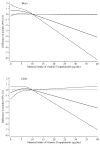Maternal Intake of Vitamin D Supplements during Pregnancy and Pubertal Timing in Children: A Population-Based Follow-Up Study
- PMID: 37764822
- PMCID: PMC10536415
- DOI: 10.3390/nu15184039
Maternal Intake of Vitamin D Supplements during Pregnancy and Pubertal Timing in Children: A Population-Based Follow-Up Study
Abstract
Maternal vitamin D may be important for several organ systems in the offspring, including the reproductive system. In this population-based follow-up study of 12,991 Danish boys and girls born 2000-2003, we investigated if maternal intake of vitamin D supplements during pregnancy was associated with pubertal timing in boys and girls. Information on maternal intake of vitamin D supplements was obtained by self-report in mid-pregnancy. Self-reported information on the current status of various pubertal milestones was obtained every six months throughout puberty. Mean differences in months at attaining each pubertal milestone and an average estimate for the mean difference in attaining all pubertal milestones were estimated according to maternal intake of vitamin D supplements using multivariable interval-censored regression models. Lower maternal intake of vitamin D supplements was associated with later pubertal timing in boys. For the average estimate, boys had 0.5 months (95% CI 0.1; 0.9) later pubertal timing per 5 µg/day lower maternal vitamin D supplement intake. Maternal intake of vitamin D supplements was not associated with pubertal timing in girls. Spline plots and sensitivity analyses supported the findings. Whether the observed association with boys' pubertal timing translates into an increased risk of disease in adulthood is unknown.
Keywords: Vitamin D; micronutrient; prenatal exposures; reproductive development.
Conflict of interest statement
The authors declare no conflict of interest. The funding source had no role in the design, execution, interpretation, or writing of the study.
Figures


Similar articles
-
Maternal intake of folate and folic acid during pregnancy and pubertal timing in girls and boys: A population-based cohort study.Paediatr Perinat Epidemiol. 2023 Sep;37(7):618-629. doi: 10.1111/ppe.12981. Epub 2023 May 2. Paediatr Perinat Epidemiol. 2023. PMID: 37132131
-
The estimated effect of season and vitamin D in the first trimester on pubertal timing in girls and boys: a cohort study and an instrumental variable analysis.Int J Epidemiol. 2023 Oct 5;52(5):1328-1340. doi: 10.1093/ije/dyad060. Int J Epidemiol. 2023. PMID: 37178177 Free PMC article.
-
Maternal stress in pregnancy and pubertal timing in girls and boys: a cohort study.Fertil Steril. 2024 Oct;122(4):715-726. doi: 10.1016/j.fertnstert.2024.06.001. Epub 2024 Jun 5. Fertil Steril. 2024. PMID: 38848953
-
Prenatal and postnatal exposures to endocrine disrupting chemicals and timing of pubertal onset in girls and boys: a systematic review and meta-analysis.Hum Reprod Update. 2022 Aug 25;28(5):687-716. doi: 10.1093/humupd/dmac013. Hum Reprod Update. 2022. PMID: 35466359 Free PMC article.
-
Pubertal timing in boys and girls born to mothers with gestational diabetes mellitus: a systematic review.Eur J Endocrinol. 2021 Jan;184(1):51-64. doi: 10.1530/EJE-20-0296. Eur J Endocrinol. 2021. PMID: 33112263 Free PMC article.
References
-
- Institute of Medicine (US) Committee to Review Dietary Reference Intakes for Vitamin D and Calcium . The National Academies Collection: Reports funded by National Institutes of Health. In: Ross A.C., Taylor C.L., Yaktine A.L., Del Valle H.B., editors. Dietary Reference Intakes for Calcium and Vitamin D. National Academy of Sciences; Washington, DC, USA: 2011. National Academies Press (US) - PubMed
-
- Pilz S., Zittermann A., Obeid R., Hahn A., Pludowski P., Trummer C., Lerchbaum E., Perez-Lopez F.R., Karras S.N., Marz W. The Role of Vitamin D in Fertility and during Pregnancy and Lactation: A Review of Clinical Data. Int. J. Environ. Res. Public Health. 2018;15:2241. doi: 10.3390/ijerph15102241. - DOI - PMC - PubMed
Grants and funding
LinkOut - more resources
Full Text Sources

